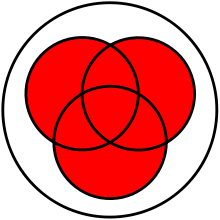- Logical disjunction
-
"Disjunction" redirects here. For separation of chromosomes, see Meiosis. For disjunctions in distribution, see Disjunct distribution.
In logic and mathematics, a two-place logical connective or, is a logical disjunction, also known as inclusive disjunction or alternation, that results in true whenever one or more of its operands are true. E.g. in this context, "A or B" is true if A is true, or if B is true, or if both A and B are true. In grammar, or is a coordinating conjunction.
In ordinary language, i.e. outside of contexts such as formal logic, mathematics and programming, "or" sometimes has the meaning of exclusive disjunction. E.g. "Please ring me or send an email" means "do one or the other, but not both". On the other hand, "Her grades are so good that she's either very bright or studies hard" allows for the possibility that the person is both bright and works hard. In other words, in ordinary language 'or' can mean inclusive or exclusive or. Usually it is clear from the context which is the intended meaning.
Contents
Notation
Or is usually expressed with the prefix operator A, or with an infix operator. In mathematics and logic, the infix operator is usually ∨; in electronics, +; and in programming languages, | or or. Some programming languages have a related control structure, the short-circuit or, written ||, or else, etc.
Definition
Logical disjunction is an operation on two logical values, typically the values of two propositions, that produces a value of false if and only if both of its operands are false. More generally a disjunction is a logical formula that can have one or more literals separated only by ORs. A single literal is often considered to be a degenerate disjunction.
Truth table
The truth table of
 :
:INPUT OUTPUT A B A OR B 0 0 0 0 1 1 1 0 1 1 1 1 Properties
commutativity: yes






associativity: yes
















distributivity: with various operations, especially with and
















others with biconditional:
















with material implication:
















with itself:
















idempotency: yes










monotonicity: yes












truth-preserving: yes
When all inputs are true, the output is true.





(to be tested) falsehood-preserving: yes
When all inputs are false, the output is false.





(to be tested) Walsh spectrum: (3,-1,-1,-1)
Nonlinearity: 1 (the function is bent)
If using binary values for true (1) and false (0), then logical disjunction works almost like binary addition. The only difference is that
 , while 1 + 1 = 10.
, while 1 + 1 = 10.Symbol
The mathematical symbol for logical disjunction varies in the literature. In addition to the word "or", and the formula "Apq", the symbol "
 ", deriving from the Latin word vel for "or", is commonly used for disjunction. For example: "A
", deriving from the Latin word vel for "or", is commonly used for disjunction. For example: "A  B " is read as "A or B ". Such a disjunction is false if both A and B are false. In all other cases it is true.
B " is read as "A or B ". Such a disjunction is false if both A and B are false. In all other cases it is true.All of the following are disjunctions:
The corresponding operation in set theory is the set-theoretic union.
Applications in computer science
Operators corresponding to logical disjunction exist in most programming languages.
Bitwise operation
Disjunction is often used for bitwise operations. Examples:
- 0 or 0 = 0
- 0 or 1 = 1
- 1 or 0 = 1
- 1 or 1 = 1
- 1010 or 1100 = 1110
The
oroperator can be used to set bits in a bitfield to 1, byor-ing the field with a constant field with the relevant bits set to 1. For example,x = x | 0b00000001will force the final bit to 1 while leaving other bits unchanged.Logical operation
Many languages distinguish between bitwise and logical disjunction by providing two distinct operators; in languages following C, bitwise disjunction is performed with the single pipe (
|) and logical disjunction with the double pipe (||) operators.Logical disjunction is usually short-circuited; that is, if the first (left) operand evaluates to
truethen the second (right) operand is not evaluated. The logical disjunction operator thus usually constitutes a sequence point.Although in most languages the type of a logical disjunction expression is boolean and thus can only have the value
trueorfalse, in some (such as Python and JavaScript) the logical disjunction operator returns one of its operands: the first operand if it evaluates to a true value, and the second operand otherwise.Constructive disjunction
The Curry-Howard correspondence relates a constructivist form of disjunction to tagged union types.
Union
The union used in set theory is defined in terms of a logical disjunction: x ∈ A ∪ B if and only if (x ∈ A) ∨ (x ∈ B). Because of this, logical disjunction satisfies many of the same identities as set-theoretic union, such as associativity, commutativity, distributivity, and de Morgan's laws.
Notes
- Boole, closely following analogy with ordinary mathematics, premised, as a necessary condition to the definition of "x + y", that x and y were mutually exclusive. Jevons, and practically all mathematical logicians after him, advocated, on various grounds, the definition of "logical addition" in a form which does not necessitate mutual exclusiveness.
See also
- Logical conjunction
- Logical negation
- Exclusive disjunction
- Affirming a disjunct
- Bitwise OR
- Boolean algebra (logic)
- Boolean algebra topics
- Boolean domain
External links
- Stanford Encyclopedia of Philosophy entry
- Eric W. Weisstein. "Disjunction." From MathWorld--A Wolfram Web Resource
Logical connectives  Categories:
Categories:- Logical connectives
- Boolean algebra
- Binary operations
- Propositional calculus
Wikimedia Foundation. 2010.
















